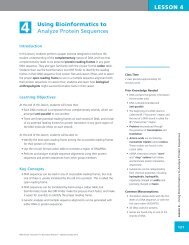WET LAB DNA Barcoding: From Samples to Sequences - Northwest ...
WET LAB DNA Barcoding: From Samples to Sequences - Northwest ...
WET LAB DNA Barcoding: From Samples to Sequences - Northwest ...
You also want an ePaper? Increase the reach of your titles
YUMPU automatically turns print PDFs into web optimized ePapers that Google loves.
<strong>WET</strong> <strong>LAB</strong><br />
PCR beads: Lyophilized or “freeze-dried” PCR ingredients.<br />
PCR product: The <strong>DNA</strong> copied or “amplified” during PCR.<br />
PCR purification: Extracting or purifying the PCR product (<strong>DNA</strong> fragment) away from the remaining PCR components.<br />
Pellet: After centrifugation, the pellet is the material found at the bot<strong>to</strong>m of the tube.<br />
Phosphodiester bond: A phosphodiester bond is a strong covalent bond between a phosphate group and two five-carbon<br />
ring carbohydrates. <strong>DNA</strong> polymerase catalyzes the formation of phosphodiester bonds between the 3’ hydroxyl group<br />
on the deoxyribose at the end of a <strong>DNA</strong> strand and the phosphate group attached <strong>to</strong> the 5’ carbon of the deoxyribose on<br />
the new <strong>DNA</strong> nucleotide.<br />
Polymerase Chain Reaction (PCR): A scientific technique in molecular biology used <strong>to</strong> amplify (i.e., copy) a single<br />
or a few copies of a piece of <strong>DNA</strong> across several orders of magnitude, generating thousands <strong>to</strong> millions of copies of a<br />
particular <strong>DNA</strong> sequence.<br />
Power supply: Used <strong>to</strong> create the electrical field <strong>to</strong> which the <strong>DNA</strong> will be subjected during agarose gel electrophoresis.<br />
Primer pools: Collections or mixtures of primers, usually used in PCR.<br />
Primers: Small pieces of <strong>DNA</strong> used <strong>to</strong> start or “prime” <strong>DNA</strong> synthesis, as in <strong>DNA</strong> replication and PCR.<br />
Proteinase K: Type of enzyme that breaks down proteins, including nucleases.<br />
Reagents: Ingredients or components used in an experiment.<br />
Sanger sequencing: A method of <strong>DNA</strong> sequencing that uses deoxyribonucleaotides (dNTPs) and<br />
dideoxyribonucleotide triphosphates (ddNTPs). The ddNTPs end <strong>DNA</strong> synthesis at random positions, and the resulting<br />
fragments can be analyzed <strong>to</strong> determine the exact <strong>DNA</strong> sequence. For more on Sanger sequencing, see also <strong>DNA</strong><br />
sequencing.<br />
Spin column: A small column that fits inside of a microfuge tube and contains a material (such as silica) that binds <strong>to</strong><br />
nucleic acids such as <strong>DNA</strong>. The spin column is used in conjunction with centrifugation (or vacuum pressure) <strong>to</strong> purify <strong>DNA</strong>.<br />
Supernatant: After centrifugation, the supernatant is the liquid found above the pellet.<br />
Taq <strong>DNA</strong> polymerase: A type of heat-stable <strong>DNA</strong> polymerase, purified from the thermophilic (“heat-loving”) bacteria<br />
Thermus aquaticus.<br />
Template: See <strong>DNA</strong> template.<br />
Thermocycler: Type of machine used <strong>to</strong> au<strong>to</strong>mate polymerase chain reaction that cycles through all of the temperatures<br />
required <strong>to</strong> complete the PCR.<br />
Total <strong>DNA</strong>: All of the <strong>DNA</strong> found in a cell, including the <strong>DNA</strong> in the nucleus and in the mi<strong>to</strong>chondria.<br />
Wells: Holes in a gel in<strong>to</strong> which samples are placed or “loaded.”<br />
3’ hydroxyl group: During <strong>DNA</strong> synthesis, <strong>DNA</strong> polymerase catalyzes the formation of a phosphodiester bond<br />
between the 3’ hydroxyl group on the deoxyribose at the end of a <strong>DNA</strong> strand and the phosphate group attached <strong>to</strong> the 5’<br />
carbon of the deoxyribose on the new <strong>DNA</strong> nucleotide. See also <strong>DNA</strong> sequencing.<br />
Wet Lab – <strong>DNA</strong> <strong>Barcoding</strong>: <strong>From</strong> <strong>Samples</strong> <strong>to</strong> <strong>Sequences</strong><br />
347<br />
©<strong>Northwest</strong> Association for Biomedical Research—Updated Oc<strong>to</strong>ber 2012
















